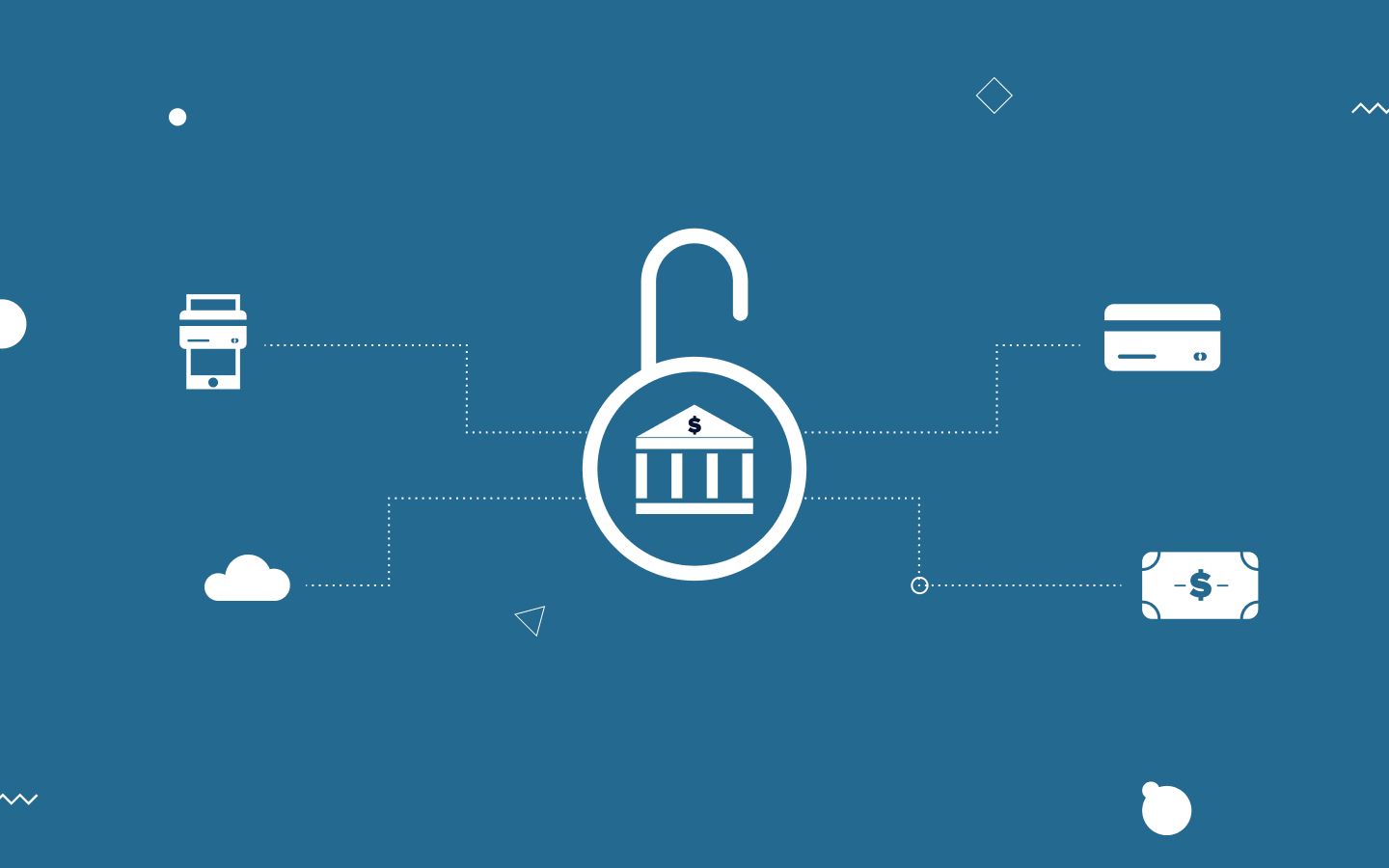The advent of the internet and new technologies has tremendously revolutionized the financial and banking sector. It is continuously evolving and is potent to attract numerous customers in the coming years.
The main problem that has been a barricade in this digital transformation is integration. It is costly and tough to integrate new technologies into the existing infrastructure as the banking system and the applications used are independent.
To solve this problem and enable service systems like open banking, we can use APIs.
What is open banking?
Open banking is an innovative concept where the banks provide access to third-party financial service providers. The open banking architecture mainly comprises APIs.
For instance, let us suppose a customer would like to know his account balance. In this case, customers will request this information from a bank or FinTech using the developer's application. The application will then redirect the request to the API provider. The third-party will receive the request and automatically send back the requested information using the API.
These APIs are a secure medium of communication between the banks that use API and the Third Party Companies which create the API. By using APIs, banks will be able to combine the online services offered by different companies on their own platforms. According to a report by Accenture, approx. 20% of banks have invested in open banking initiatives, and the figure is expected to rise in the coming years.
Understanding the functioning of open source banking software
The concept of open banking works on the partnership between two institutions. Generally, these institutions are traditional banks and third-party service providers (TPPs).
APIs allow this TTP to access financial information effectively. Customers need to show consent in some form to allow such access. Once access is provided, a unified platform can be created. The platform aggregates all financial information and promotes the development of innovative services and applications.
What are open banking APIs?
API stands for Application Programming Interface. APIs act as a mode or channel for two independent applications to share information and communicate with each other.
In simpler words, APIs enable two or multiple applications to talk with each other using a common language. The concept of open banking is standardized and regulated using APIs.
The transparency of the open banking system depends upon the type of API used.
Types of APIs
Public APIs: Third-party service providers use these APIs to extract data and commercialize them. These APIs facilitate external innovation.
Partner APIs: Partnered businesses share partner APIs among them. These APIs facilitate co-innovation and provide additional revenue by extending distribution and new business models.
Private APIs: This API is used internally within a company. They are secure, agile, and operationally effective. These APIs facilitate system integration in a company.
Who benefits from open banking APIs?
The open banking system highly benefits the consumers. However, the benefits are not limited to consumers only. Service providers and all others associated with it have an advantage too.
Customers:
Open banking system lets customers choose from diverse options to select the services they want to receive. It also enables customers to engage with their financial data either through internal credit score service or external tax filing system, thus making the banking system more innovative and efficient.
In a survey conducted with 5000 EU customers, 69% of them responded that having a bank that is innovative in its approach is important for them, and only 12% of them considered their own banks innovative. In quest of latest technologies, 33% customers are ready to switch their bank as well. Moreover, with open banking APIs, customers don't have to wait in long queues to make payments, which reduces a significant amount of waiting/unproductive time. So, it shows that with the help of open banking, traditional banks have been able to provide innovative capabilities to their customers largely.
Some other benefits that customers receive are:
· Customized options and enhanced personalization of services.
· Affordable international currency exchange and remittance.
· Greater transparency and accessibility to multiple accounts in a single place.
· View financial standing with just a click on your smartphone.
Service providers:
Traditional banks and service providers gain a collaborative advantage in the open banking system. They can stay ahead in the competition and follow an innovative and futuristic approach to customize the customer experience and services. According to a State of Enterprise Open Source Report, 93% of financial services institutions believe that open source technologies will help in meeting the current and future plans with respect to innovation and taking advantage of cloud architectures. Open banking systems present banks and services with an opportunity to be more customer-oriented in the following ways:
- Open banking puts the power in the hands of customers and small businesses. It enables them to share data with third parties and service providers securely and rely less on the functioning of banks.
- Creates a single platform and allows customers to handle multiple accounts without any hassle.
- The open banking system establishes Trust, Transparency, and Accessibility in operations. With 20% of total financial transactions happening online, the number is expected to grow by 12.7% in 2021. This number depicts the shift of trust in the favor of an open relationship among customers and service providers.
- Allows customers to compare the products provided by different service providers and choose according to their preferences.
- Increases customer satisfaction and improves long-term profitability along with market competition. 35% of commercial customers have already participated in open banking, and 42% plan to do so in 2021.
How will open banking APIs and iPaaS change the future of banking?
Comprehensive API management is essential to build a robust and innovative ecosystem of open banking.
iPaaS is well-suited to build this system.
iPaaS stands for Integration Platform as a service. It provides cloud-based services for data, process, and application integration.
Thus, with iPaaS, we can build and deploy integrations within a cloud or between a cloud and an enterprise. iPaaS serves as a dynamic foundation to establish the lifecycle of open banking concepts.
5 ways in which open APIs change the face of banking:
Greater customer-centric services: With open banking, the customers can approach multiple service providers who can offer customized services based on the customer's preferences and credit history.
Promote healthy competition: With growing competition, many banks are now looking to leverage FinTech and third-party service providers to provide innovative products to their customers.
Build an inclusive ecosystem: Custom services combined with the increasing competition will attract more and more consumers to be a part of this innovation.
Transparent transactions: The open banking system is potent for increasing transparency of financial institutions while protecting consumer rights. Banks will have to disclose their information to the customer, which will help them evaluate the quality of service offered.
Improved scope for innovations.: Making technology open and accessible to all can fetch novel outcomes. The creative efforts of partnered institutions can bring about disruptive business changes.
Thereby, using this approach, financial institutions can follow more customer-focused services. Open banking and iPaaS will improve customer engagement and will provide a next-level digital experience altogether.
Open banking: what’s happening currently?
According to Allied Market Research, the open banking market is rising by 24.4.% and is expected to grow by $43.15 billion by the end of 2026.
- With the COVID-19 pandemic, the impact of open banking has increased manifold. Research between OBIE and Ipsos MORI depicted that 50% SMEs have already started using open banking since the start of global pandemic.
- 87% of world countries currently have some type of open APIs, as per the open banking report of 2019.
- The OBIE has more than 135 regulated entities in their open banking system, and 30% of their banks have already incorporated open banking in its functioning.
Innovations with FinTech APIs
The financial sector has embraced banking automation products and up-gradation much earlier when compared with other industries. It wouldn't be wrong to say that APIs are now fueling a majority of FinTech's innovations. According to the World Retail Banking Report, 75% of FinTech plan to integrate banking APIs in order to ensure a smooth customer experience. Most FinTech now use cloud services to float their product on a decentralized database.
APIs are helping banks in integrating banking data to create a cost-effective model. This model enables banks to fetch any account details in seconds. APIs are also bringing about more openness and transparency to the FinTechs.
By transforming banks into a platform-based model, FinTech can uncover banks to new functionalities that enable them to participate in the market, fix their position within the value chain, and maintain their stature.
Related: What is FinTech? - APIs in FinTech, and FinTech Use Cases
Does open banking make sense for India?
The banking sector in India has already entered the digital era and has transformed its functioning over the last few years. Internet banking and mobile banking have made banking more accessible to its customers. The rise of digital wallets facilitating P2P money transfer, UPI, and SBI led blockchain platform has been a significant evolution in the history of the Indian open banking ecosystem up till now.
The UPI has been one of the greatest examples of accelerated digitization of payments in India which has grown about 10.5% in the past few years and accounts for about 30% of total retail transactions. The open banking concept will tremendously stir up the existing system making it more approachable and transparent. It promises to be a substantial advancement in the financial sector.
Quickwork platform for open banking
The digital transformation of financial institutions is a doorway to limitless possibilities. Nowadays, it has become imperative for FinTech hubs to allow banks, customers and third-party websites to collaboratively create digital products, and services easily.
To accomplish this goal, financial companies need a comprehensive way to integrate public and private IT infrastructure in real-time.
However, integrating public and private IT infrastructure in real-time is a cumbersome task that requires a large IT team and business experts. This is where Quickwork comes into the picture.
Quickwork is a unified platform that offers FinTech companies high-level infrastructure services focused mainly on Integration, API Management, and Conversation Management.
Integration as a service: Integration capability comes with a plethora of preconnected applications ranging from a variety of financial and non-financial systems like business, compliance, messaging, AI, analytics and much more.
API management as a service: Using Quickwork, you can create, manage and publish API with just a few clicks and connect with other systems effectively.
Conversation management as a service: It again allows FinTech to carry financial transactions smoothly across various messaging platforms in real-time and enable the customer to interact with UN agents and chatbots in multiple languages.
Quickwork offers these services on cloud, on-premises, hybrid, and in the embedded form. Due to this versatility, it has become a widely popular choice for financial automation and integration.
Conclusion
Open banking has some pitfalls, the prime being security issues. However, it is looked at positively due to its futuristic capabilities. It has the potential to overcome the market barriers and take banking to a higher level.
For example, open banking can bring about investment banking automation. We have come a long way from depending on banks for every little detail to fetching it within seconds on our smartphones. There is still a long way to go to innovation in the financial sector.
Open banking will lead to the renaissance of the banking era. It has the power to attract swathes of customers. This platform-based banking approach can scale and thrive the business.








